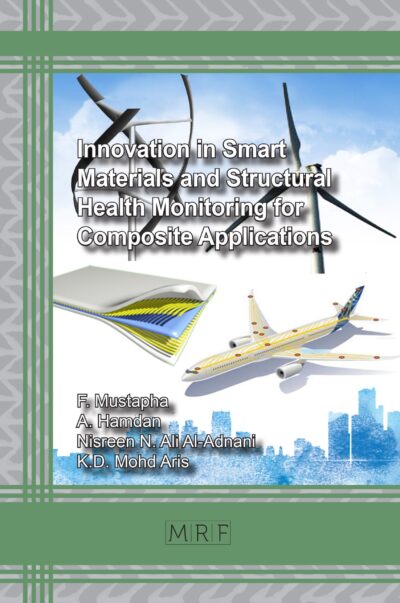Advances in Bricks and Blocks for Building Construction
Mohammad Arif Kamal
Materials Research Foundations Vol. 108
Publication Date 2021, 122 Pages
Print ISBN 978-1-64490-150-2 (release date September 2021)
ePDF ISBN 978-1-64490-151-9
DOI: 10.21741/9781644901519
The book reviews the current state of bricks and blocks; their manufacture, properties and applications in the building construction sector.
Keywords
Bricks and Blocks, Fly Ash Bricks, Calcium Silicate Bricks, Autoclaved Aerated Concrete (AAC) Blocks, Compressed Earth Blocks, Stabilized Mud Blocks, Concrete Blocks, Reinforced Hollow Concrete Block Masonry, Concrete Pavement Blocks, Beams with Longitudinal Reinforcements, Surface Textures, Smooth Surfaces, Fluted or Rough Finishes, Automated Production
Table of contents
Preface 3
Bricks and Blocks 1
1. Introduction 1
2. Bricks 1
3. Different Applications of Bricks 2
4. Properties of bricks 2
5. Types of bricks 3
6. Advantage of brick masonry 5
7. Disadvantage of brick masonry 5
8. Considerations for good brick masonry 6
9. Blocks 6
10. Advantages of concrete building blocks 8
11. Difference between red bricks and solid concrete blocks 9
Conclusion 11
References 11
Fly Ash Bricks 12
1. Introduction 12
2. Ancient lime-pozzolanic chemistry 13
3. Types of fly ash bricks 13
4. The FaL-G technology 14
5. Specifications and characteristics of fly ash bricks 15
6. Manufacturing process 17
7. Properties of fly ash affecting the strength of fly ash bricks 19
8. Benefits of fly ash bricks for the environment 20
9. Durability of fly ash bricks 20
10. Advantages of fly ash bricks 21
11. Disadvantages and limitations of fly ash bricks 21
12. Comparison of fly ash bricks with clay bricks 22
Conclusion 23
References 23
Calcium Silicate Bricks 24
1. Introduction 24
2. Materials used for sand lime bricks 24
3. History of calcium silicate bricks 26
4. Manufacturing of calcium silicate bricks 26
5. Properties of sand lime bricks 29
6. Advantages of calcium silicate bricks 29
7. Disadvantages of calcium silicate bricks 30
8. Problems associated with calcium silicate bricks 31
Conclusion 32
References 32
Autoclaved Aerated Concrete (AAC) Blocks 33
1. Introduction 33
2. Raw materials used in manufacturing of AAC blocks 34
3. Specifications and performance summary of AAC blocks 34
4. Autoclaved aerated concrete (AAC) block walling system 38
5. Advantages of using AAC blocks 41
6. Disadvantages of AAC blocks 42
7. Comparative analysis of AAC blocks, clay bricks, and CLC blocks 43
8. Cost comparative analysis of AAC blockb, Clay Bricks, and CLC blocks 45
9. Environmental benefits of AAC blocks 46
Conclusion 46
References 47
Compressed Earth Blocks 49
1. Introduction 49
2. Basic components 49
3. Addition of a binding agent 50
4. Block making machines 51
5. Manufacturing process 53
6. Size of blocks 55
7. Walling with soil cement blocks 55
8. Earthquake resistance of blocks 56
9. Energy savings 57
10. Advantages of compressed earth blocks 57
Stabilized Mud Blocks 59
1. Introduction 59
2. Soil Stabilization methods with different materials 60
3. Identification of soil 62
4. Soil stabilization 62
5. Raw materials 63
6. Preparations of raw materials 64
7. Molding of stabilized mud blocks 67
8. Advantages of compressed stabilized earth blocks (CSEB) 69
9. Disadvantages of compressed stabilized earth blocks (CSEB) 70
Conclusion 71
References 71
Concrete Blocks 72
1. Introduction 72
2. Historical background of concrete blocks 73
3. Raw materials for precast concrete blocks 73
4. Design of precast concrete blocks 74
5. Concrete block construction method 75
6. Concrete block specifications 77
7. Types of concrete block or concrete masonry units 79
8. Types of hollow concrete blocks 81
9. Size of concrete blocks 85
10. Building with concrete blocks 85
11. Construction of precast concrete block masonry 86
12. Advantages of concrete blocks 87
13. Comparison of hollow block and brick masonry 88
Conclusion 89
References 89
Reinforced Hollow Concrete Block Masonry 90
1. Introduction 90
2. Reinforced hollow concrete block wall 90
3. Structural hollow concrete blocks 91
4. Structural features 92
5. Precaution while laying RHCB masonry 93
6. Design details 94
References 97
Concrete Pavement Blocks 98
1. Introduction 98
2. Specifications of Grass Paver 99
3. Types of interlocking paver blocks 100
4. Manufacturing of pavement blocks 102
5. Laying of pavement blocks 103
6. Characteristics features of pavement blocks 104
7. Advantages over conventional rigid concrete pavement blocks 105
Conclusion 107
References 108
About the Author 109














